Summary
One of Raffles’ key contributions to Singapore’s early beginnings was a land-use plan later known as the Raffles Town Plan.
However, the Raffles Town Plan guided the city's growth for less than a decade. By the early 1900s, in the absence of an updated town plan and with the lack of control by the British government, the city area had become severely overcrowded with slums sprung up in the older sectors of the city and in the outlying areas. The roads had also become congested, unable to cope with the growth of motor transport.
Step into the minds of the planners who have shaped our city. Learn of the nation’s planning challenges and creative solutions to balancing different competing needs; living, working, and playing as well as extensive conservation efforts and urban design strategies to create a more distinctive Singapore.
Discover how Singapore transformed; from her colonial city parentage to a vibrant metropolis with world-class facilities and space enough for greenery and gracious living.
Highlights
Founding of Singapore and the original Town Plan. Migration of communities away from the City Area. Infrastructure (transport, water, nature reserves / parks). National development trends (pre-war, post-war, 60s-70s, 80s-90s, 2000s). Planning cycles (Concept Plan, Master Plan, Identity Plans). Targets (Population White Paper, Land Use Plan, Transport Master Plan).
Tour Details
Please see sidebar for full overview.
Meals Food & Beverage excluded.
Not Included Transfers to / from airport / hotel, porterage, tips, entrance fees to places of entertainment unless specified.
Advisory Light tropical clothing is recommended with comfortable walking shoes. Please ensure sufficient personal insurance cover during tour.
Accessibility & Fitness Minimum fitness level. Total walking distance is about 1km on flat grounds but there may be some staircases during journey.
Itinerary
URA’s City Gallery





